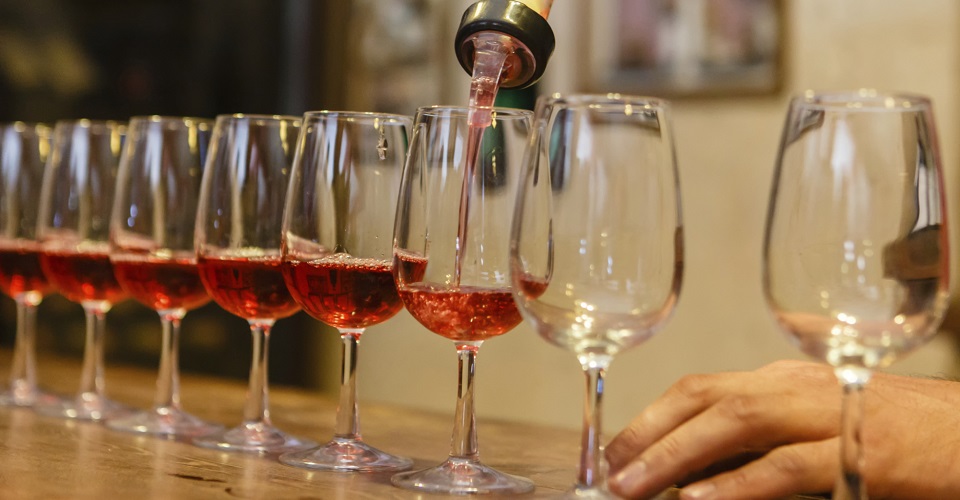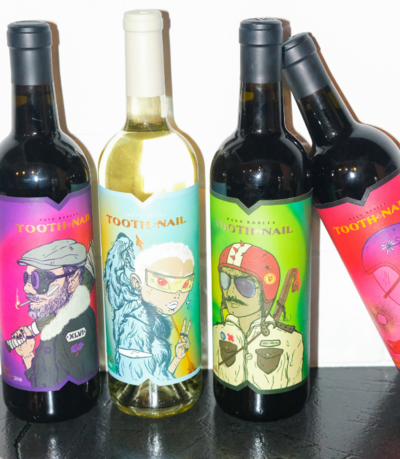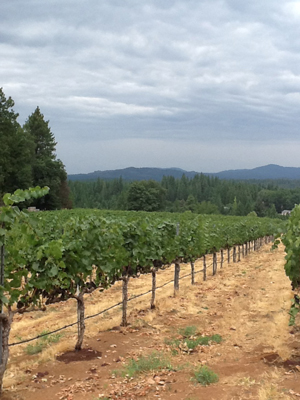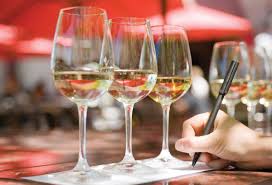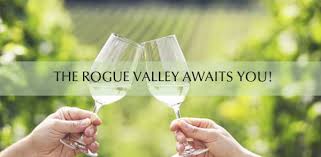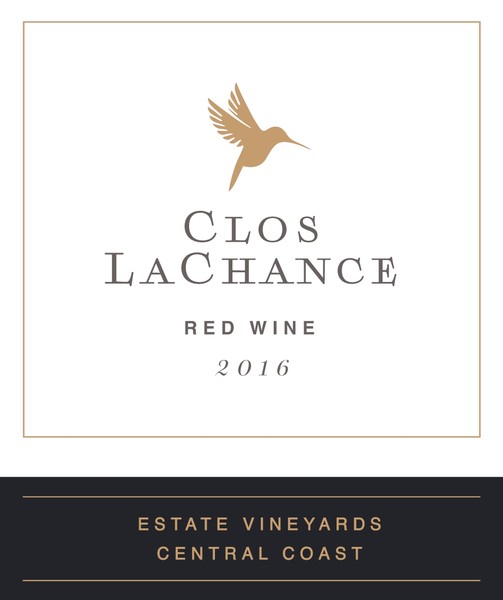Having long been intrigued by Rhone wines, I regularly check out theTablas Creek Vineyards blog. A recent post mentioning the availability of Terret Noir and Bourboulenc stopped me in my tracks. Of all the varieties permitted to grow in Chateauneuf-du-Pape these two were total mysteries to me.
Never one to pass up an opportunity to try a new wine and maybe learn something along the way, I reached out to Jason Hass. As always, he was helpful and informative and kindly made it possible for me to taste these two new Tablas Creek wines.
In wildly different ways, both the Bourboulenc and the Terret Noir were exciting new experiences. That set me off on a mission to explore other lesser known Rhone varieties, those usually dismissed or ignored as blenders, to see what they might offer as varietal wines.
But first, here are my notes on those two amazing wines that had me saddling up for this journey:
Tablas Creek Vineyard Adelaida Hills District Paso Robles Bourboulenc 2022 $40
From 2/3rd of an acre, this is the winery’s 4th Bourboulenc and it is wonderfully unusual. Medium straw in color, it offers an intriguing aromatic mix of orange rind, apricot and lychee nut. Surprisingly rich and round on the palate, it combines orange and citrus flavors with a hint of stone fruit. The texture is rich, and then it finishes with a rush of lemony flavors and bright acidity. All of this is to be enjoyed in a refreshing wine with only 12% alcohol. To summarize: lovely aromas, terrific texture, mouthwatering flavors and youthful acidity holding it together. A great food wine. What’s not to like? 94
Tablas Creek Vineyard Adelaida Hills District Paso Robles Terret Noir 2021 $40
Originally from the Languedoc, Terret Noir has seldom been made on its own, most often blended with Grenache or its fellow family members,Terret Gris and Terret Blanche. Tablas Creek bottled 70 cases in 2021 and offers it at the winery. Once poured, it has an unusual light red color that sets it apart from most red wines. The aroma is also strikingly unusual, neither berry-ish nor overtly fruity, it offers a pretty floral nose of roses and orange blossom. While light medium bodied at best, it delivers refreshing flavors reminiscent of red currants that are sustained and persistent. Gentle, fresh and lively in the finish, it is all together pleasant and refreshing. It is a fun party or aperitif style red. Fun is good, right? 92
My takeaway after trying these two unusual wines was a suspicion that there probably are other lesser-known Rhone blending varieties that might be worthwhile looking into. And sure enough, by continuing along the Rhone road less traveled, I encountered four other Rhone varieties that also have much to offer as stand alone wines and, best of all, these four are being made by several key California winemakers, a few original Rhone Rangers and some new, younger folks dedicated to Rhone wines.
The four wines are two whites, Marsanne and Roussanne and two reds, Cinsaut and Counoise. Grenache Gris was on my list, but not many are available. Picpoul wines are enjoying a well-deserved surge, but are not as unusual as are Roussanne and Marsanne.
Marsanne is hardly a newcomer since Bob Lindquist who founded Qupe, made California’s first back in 1987. But it is still usually downplayed as part of a blend with Viognier or Roussanne. And while there are many attractive blends now coming from Australia and Santa Barbera, on its own, Marsanne is still not that common.
And from what I’ve experienced at this early stage, I can only wonder why. Marsanne is, afterall, the white grape of Hermitage fame. The 2022 Marsanne from Starfield Vineyards in El Dorado is a fantastic, complex and stunning version and it was a great wine to begin the journey.
Starfield Vineyards El Dorado Marsanne 2022 $34
Aged for 6 months in neutral French oak, this Marsanne is attractive now but has all it needs to age long and well. On the nose it comes across with ripe peach and nectarine fruitiness with citrus as well. Then on the palate which is plush and round, it has vibrant flavors of orange rind
and cloves with minerality as well. Solid and well-integrated, it continues the ripe peach, apricot theme in its lengthy finish. Overall, it is concentrated but so lively it invites a second glass. 165 cases made. 94
After that re-introduction to Marsanne, I reached out to Bob Lindquist who sold Qupe in 2018 but has never stopped making Marsanne. As he explains,”Marsanne and Roussanne are near and dear to me, and I continue to make both of them under my Lindquist Family label.” He adds, “In 1986 I got Marsanne budwood from Randall Grahm and grafted over some own-rooted Cabernet vines at a small vineyard just outside of Los Olivos called the Ibarra-Young Vineyard.”
Marsanne ages well, Lindquist noted, and his vintages from the early 90s are still showing well he added. As for style, he explains:” I make Marsanne in a lighter, fresher style, all in neutral barrels and bottled after about 8-9 months.”
“Lighter” it may be, but his current release is most attractive:
Lindquist Family Vineyard Edna Valley, Sawyer Lindquist Vineyard Marsanne 2020 $38
All of the fruit is grown in this the Demeter certified biodynamic vineyard. Yellow with green tint, this wine is medium bodied with lots of youthful character. Aromatically, it combines nectarine and white peach fruit along with some almond and lemony accents. Smooth and refreshing on the palate, it has good acidity for a balanced impression and concludes with lively fruit and a crisp finish. 92
At the end of our conversation, Lindquist added this zinger:”I think Roussanne makes the more important and complex wine…I make mine very much in the same style as Chardonnay.”
It turns out Roussanne is a favorite of many other winemakers. Bill Easton of Terre Rouge who makes exquisite Syrah and Viognier chimes in with this: “Roussanne is the most serious white Rhône grape. It reaches its apex with age – slow oxidation.. But it is not easy to grow.” The team at Truchard in Napa simply say “it is a challenge.” And then John Alban the unchallenged champion of Viognier adds this: “There are legions of whites that one can make for all kinds of commercial reasons, even if the resulting wines are less than compelling, but Roussanne is for people you love.”
After tasting the latest from Terre Rouge and Lindquist, I can understand the appeal. Easton offers a perfect summary of what a newcomer will encounter: “American palates are not accustomed to classic Roussanne characteristics: Straw golden color; with exquisite quince, honey-nut, and beeswax aromas.” To that I’d add exotic pineapple fragrances, rich viscosity, and depth unique among white wines. It is definitely a white on steroids. The Terre Rouge Roussanne is given several extra years of bottle aging before being released to the market.
The name “Roussanne” relates to the French word for russet which explains the wine’s dark color. In the early phase of the Rhone Ranger period, what was thought to be Roussanne turned out to be Viognier. The true Roussanne was eventually introduced by Tablas Creek, so most of the current plantings began in the late 1990s.
There’s one major exception: Terre Rouge. Its Roussanne clone is unique, originating from a Chave family parcel on the hill at Hermitage. It is the real deal and you can get a good feel for what Roussanne is capable of if you are fortunate, as I was, to taste the 2011 Terre Rouge and the 2021 Lindquist Family. See the tasting notes at the end.
Cinsaut is another Rhone that was misidentified and that’s one likely reason why it was long overlooked. It turns out that in Lodi the Bechthold Vineyard which was planted in 1886 is actually the oldest Cinsaut vineyard in the world. Until 2003 when UC Davis proved by DNA testing that it was Cinsaut, the grape was believed to be Black Malvoisie. And it was sold to home winemakers.
Often spelled Cinsault, the grape is used these days to produce Roses or in blends. It is well-represented in South Africa likely due to its parenting role in Pinotage. It was not planted at Tablas Creek until 2017, and for now the winery suggests “it will be a useful blending partner to higher-alcohol, more tannic red grapes, and it makes for delicious lighter reds on its own.”
Thanks to Holly’s Hill Vineyard in El Dorado, my most recent encounter with a varietal Cinsaut is highly memorable and is a delicious red. Here is my note:
Holly’s Hill Vineyard El Dorado Cinsaut 2020
Based on its color and the initial sniff, my instinct says this could be a Cotes du Rhone Villages. A real good one. But then after the initial taste, it comes across with subtle, but charming flavors that don’t match anything in my experience. Though Cinsaut is classified as a lightweight, this is no such thing. Its bright, fresh cranberry aroma mingles with spices and black tea, and the flavors are full of fresh picked dark cherries and an earthy, leathery back note. Balanced, with light tannin it finishes on a slightly tart note along with lingering berries. Lovely! 93
Starfield Vineyards, also based in the Sierra Foothills, impressed me earlier with its 2019 Cinsaut. It turns out one of Randall Grahm’s most recent obsessions is with Cinsaut, so he had lots to say when approached.
“But let me tell you why I’m so enamored of Cinsault…. By restricting yields aggressively – via water restriction, bunch and cluster thinning – one can actually produce a very elegant wine of heady fragrance and beautiful color. For me, this is the classical (you will forgive the expression) conundrum of how to produce an elegant, complex, let’s call it “continental” wine in a warm and dry Mediterranean climate.”
While Cinsaut seems to be gaining in traction as a Rose and as a red wine in South Africa, that leaves Counoise as the ultimate, unwanted red grape on the Chateauneuf-du-Pape team. It ripens late in the season which makes it unappealing in Southern France. Only 60 acres are planted in California today.
But like the last player drafted in pro football, it too could become the next star. Tablas Creek has 6 acres and bottles it as a single varietal from time to time. Fess Parker offers an excellent Counoise under its Epiphany label which impressed me a few years back. Others now on my radar are the new Counoise from Frick in Dry Creek Valley, Adelaida from Paso Robles and the 2019 Prie Cellars in Lodi.
However, in my most recent experience, Counoise was well-represented by Holly’s Hill and that winery seems ready for stardom based on its 2020. As winemakers Carrie and Josh Bendick explain, when their various new wines were tasted every January, the Counoise lot always stood out. Eventually, the winery converted some Syrah to Counoise. It is difficult to grow, though, they add, because it ripens unevenly and you always have to focus on its color.
Holly’s Hill Vineyard El Dorado Counoise 2020
Excellent, deep color with an aroma of raspberries, lovely baking spices and floral notes. On the palate it offers vibrant flavors of spices and berries. The subtle floral component adds intrigue and there’s plenty of crisp acidity keeping it nicely woven together. Tannins are light and smooth. And the finish is fresh and long with spices such as cinnamon and clove.
It is reminiscent of a Moulin-A-Vent in weight and direct appeal but it offers more layers as a result of the floral note and baking spices. 94
As I begin wrapping this journey up, it hits me that this Counoise like the other three wines is a food-friendly wine. Both the new and older Roussanne reviewed here were definitely serious food wines.
Lindquist Family Vineyards Santa Maria Valley Bien Nacido Hillside Roussanne 2021
From 5 acres on a west facing hillside,planted to the Tablas Creek clone between 1997-2000, Lindquist has made Roussanne from this block since 2000. It is aged on the lees in one year-old barrels for a year and then in neutral oak for 6 months. Bottled unfined and unfiltered, it is light yellow and with aeration, opens up to show pineapple, beeswax, and honey aromas with some oak. Big, generous palate, silky texture with deep flavors of ripe apples, hazelnuts and honey.
A little leesy, creamy texture and a long aftertaste of lemon curd and oak toast. 94
Domaine de la Terre Rouge Sierra Foothills Monarch Mine Vineyard Roussanne 2011
In 2011, the crop ran into mildew problems and the yield was down by 80%. Following whole cluster pressing, the juice was barrel fermented and the wine aged on the lees. Beginning with its deep golden color, this wine was a unique experience. Rich and deeply concentrated with great viscosity, it delivers ripe pear flavors with some floral notes. Maturing nicely, but still has plenty of life ahead of it. As for a rating, how about rare and wonderful.
All of the wineries singled out here sell their wines direct, so for those wanting to jump aboard and continue the journey into the unknown Rhones, here are the contacts:
www.starfieldvineyards.com
www.hollyshill.com
www.lindquistfamilywines.com
www.terrerougewines.com
So that’s it. Oh, hold on, just got a late breaking news alert from Tablas Creek about another variety:
“Vaccarèse. There are just over 10 acres planted in Chateauneuf, just a little more than that elsewhere in France, and none, until we brought in ours, elsewhere in the world. But we believe it shows great potential, with lovely dark color and floral and herbal aromatics. It’s been so good that it’s already playing a significant role in the Esprit de Tablas.”
Well, now that sounds worth exploring on another trip!
